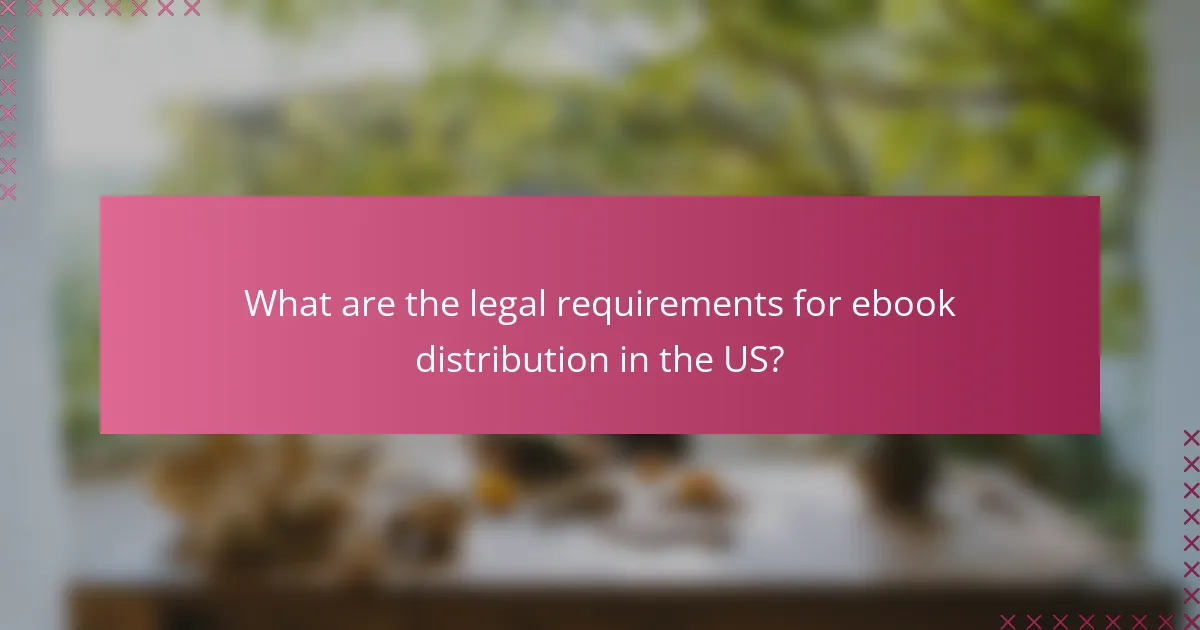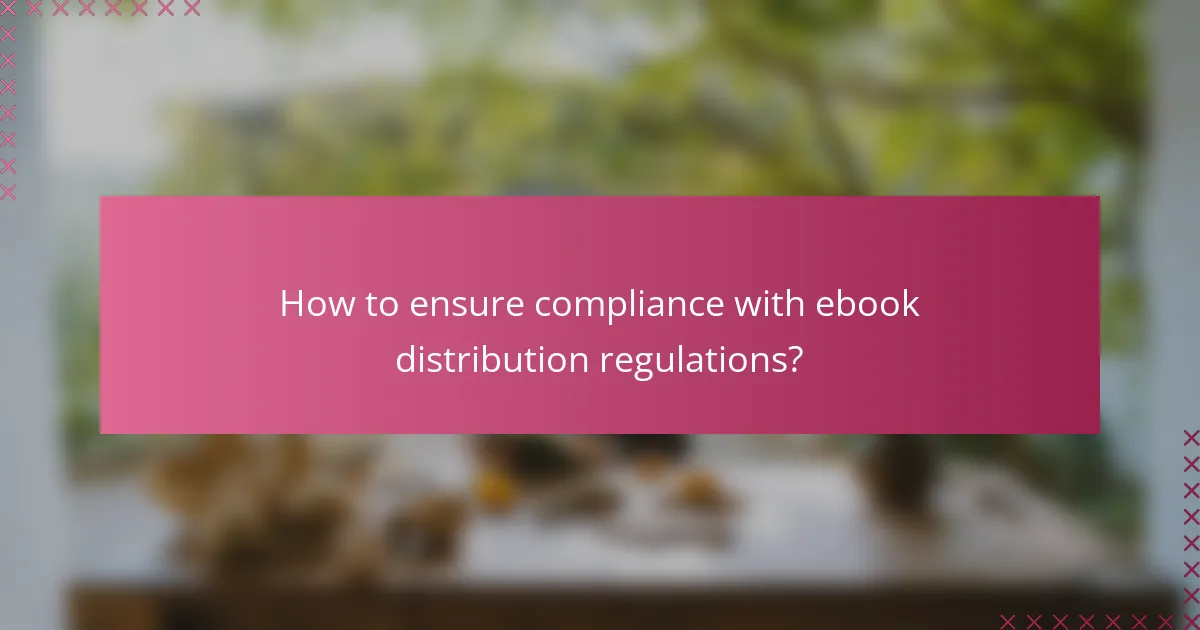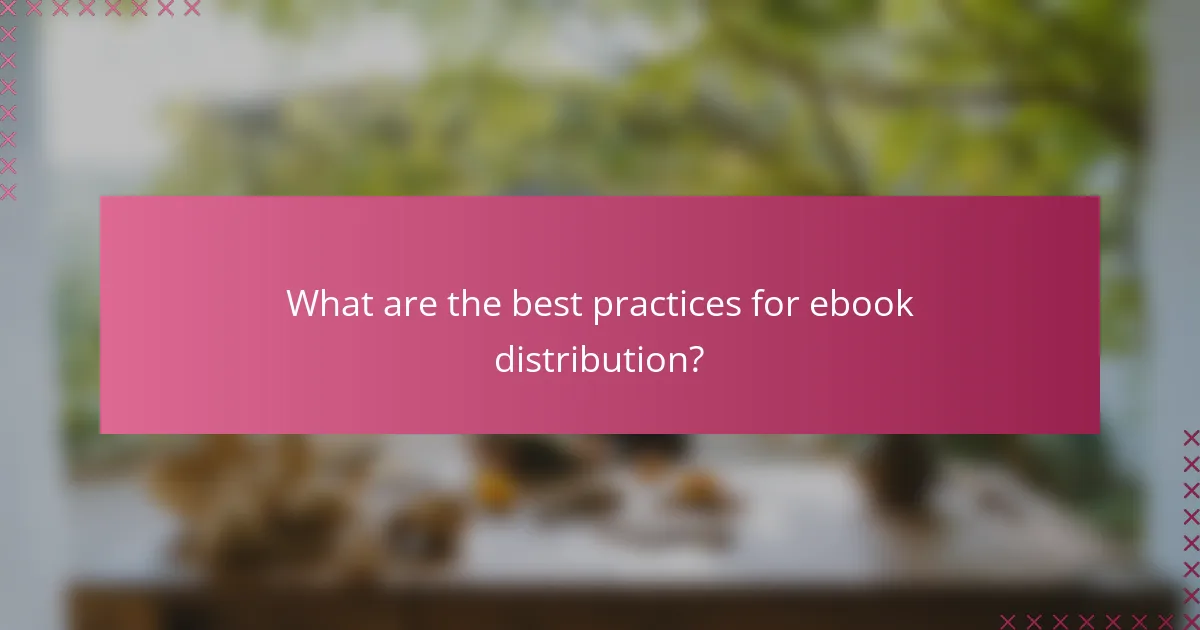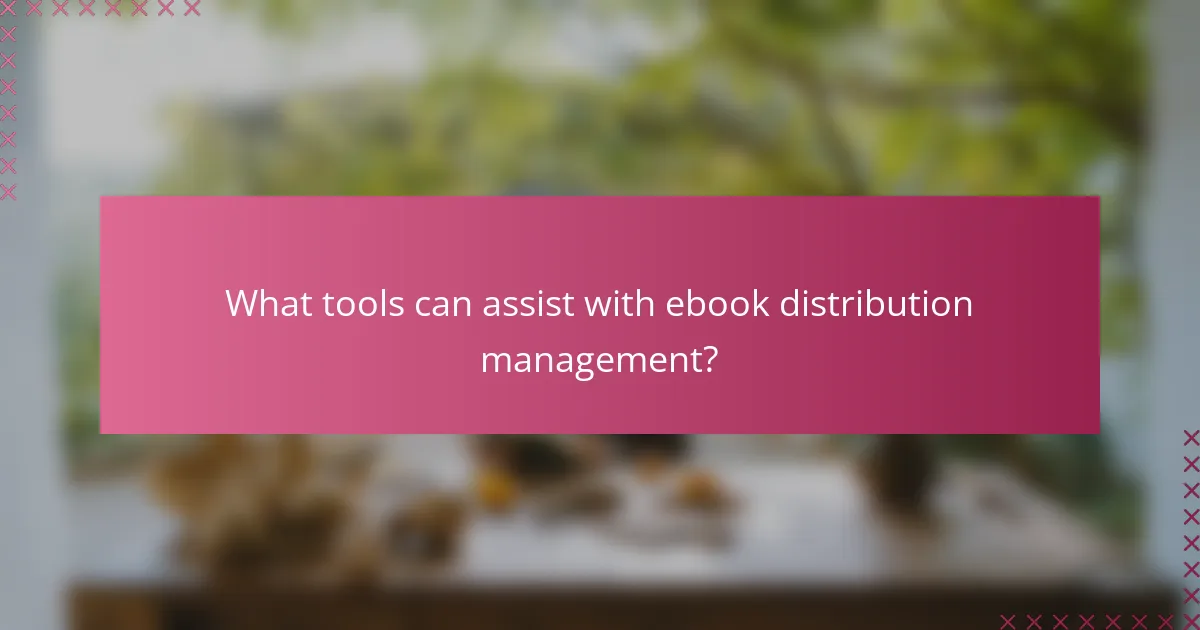Ebook distribution is governed by a complex set of legal requirements that authors and publishers must navigate to ensure compliance. Key considerations include copyright laws, ISBN registration, and adherence to privacy policies and consumer protection regulations. Understanding these legal frameworks is crucial for successful distribution in various markets, as well as for selecting the appropriate distribution model, whether through direct sales, third-party platforms, or subscription services.

What are the legal requirements for ebook distribution in the US?
In the US, ebook distribution involves several legal requirements that authors and publishers must follow to ensure compliance. Key areas include copyright compliance, ISBN registration, privacy policies, and consumer protection laws.
Copyright compliance
Copyright compliance is crucial for ebook distribution, as it protects the intellectual property rights of authors and publishers. To comply, ensure that you hold the necessary rights to the content you are distributing, whether it’s original work or licensed material.
Consider registering your copyright with the U.S. Copyright Office for additional legal protection. This registration can help in enforcing your rights in case of infringement.
ISBN registration
Obtaining an International Standard Book Number (ISBN) is important for tracking and selling your ebook. An ISBN uniquely identifies your ebook and is essential for distribution through retailers and libraries.
In the US, you can purchase ISBNs from Bowker. Each format of your ebook (e.g., PDF, EPUB) requires a separate ISBN, so plan accordingly based on your distribution strategy.
Privacy policies
When distributing ebooks, you must have a clear privacy policy that outlines how you handle user data. This is especially important if you collect personal information from readers, such as email addresses for newsletters or purchases.
Your privacy policy should comply with regulations like the California Consumer Privacy Act (CCPA) if you have customers in California. Make sure to disclose how data is collected, used, and shared.
Consumer protection laws
Consumer protection laws in the US require that you provide accurate information about your ebook, including pricing, content, and any terms of sale. Misleading claims can lead to legal issues and damage your reputation.
Familiarize yourself with the Federal Trade Commission (FTC) guidelines on advertising and marketing to ensure that your promotional materials comply with legal standards. Always be transparent about what consumers can expect from your ebook.

How to ensure compliance with ebook distribution regulations?
To ensure compliance with ebook distribution regulations, it is essential to understand the legal requirements that govern digital content in your target markets. This includes adhering to copyright laws, data protection regulations, and any specific distribution agreements.
Regular audits
Conducting regular audits of your ebook distribution practices helps identify compliance gaps and ensures adherence to applicable laws. These audits should review copyright licenses, user data handling, and distribution agreements to confirm they meet current regulations.
Consider scheduling audits at least annually or whenever significant changes occur in your distribution strategy. Use checklists to cover key areas, such as copyright status, licensing agreements, and data privacy measures.
Consulting legal experts
Engaging legal experts who specialize in intellectual property and digital distribution can provide invaluable guidance on compliance. They can help interpret complex regulations and ensure that your ebook distribution practices align with local laws.
When selecting a legal consultant, look for professionals with experience in the ebook industry and familiarity with relevant regulations, such as the Digital Millennium Copyright Act (DMCA) in the U.S. or the General Data Protection Regulation (GDPR) in Europe. Regular consultations can help you stay updated on any changes in the legal landscape that may affect your operations.

What variations exist in ebook distribution models?
Ebook distribution models vary primarily in how authors and publishers reach their audience. The main models include direct sales through personal websites, third-party platforms like Amazon Kindle, and subscription services such as Scribd.
Direct sales through websites
Direct sales allow authors to sell ebooks from their own websites, providing full control over pricing and customer relationships. This model often results in higher profit margins since there are no intermediary fees, but it requires investment in marketing and website maintenance.
Authors should consider using e-commerce platforms like Shopify or WooCommerce to facilitate transactions. It’s essential to ensure compliance with local regulations regarding digital sales and consumer rights, which can vary by country.
Third-party platforms like Amazon Kindle
Third-party platforms, particularly Amazon Kindle, offer a vast audience and established infrastructure for ebook distribution. Authors can benefit from Amazon’s marketing tools and customer base, but they must adhere to the platform’s terms and conditions, which may include sharing a percentage of sales.
Using Kindle Direct Publishing (KDP), authors can set their prices and choose between exclusive or non-exclusive distribution options. However, exclusivity can limit sales on other platforms, so authors should weigh the potential benefits against the restrictions.
Subscription services like Scribd
Subscription services like Scribd provide readers access to a library of ebooks for a monthly fee, offering authors a different revenue model based on reader engagement rather than direct sales. This model can lead to wider exposure but often results in lower per-book earnings.
Authors should evaluate the terms of service and payment structures of these platforms, as they may vary significantly. It’s crucial to understand how royalties are calculated and the potential trade-offs in visibility versus earnings.

What are the best practices for ebook distribution?
The best practices for ebook distribution focus on optimizing metadata, implementing effective pricing strategies, and ensuring compliance with marketing regulations. These elements are essential for maximizing visibility, sales, and legal adherence in the competitive ebook market.
Metadata optimization
Metadata optimization involves refining the information associated with your ebook to improve discoverability and sales. Key components include the title, author name, genre, keywords, and a compelling description. Using relevant keywords can significantly enhance searchability on platforms like Amazon and Apple Books.
Consider employing tools that analyze keyword performance and trends to ensure your metadata aligns with current consumer interests. Regularly updating your metadata based on market changes can also help maintain visibility.
Pricing strategies
Effective pricing strategies are crucial for attracting readers while maximizing revenue. Research indicates that ebooks priced between $2.99 and $9.99 often perform best, as they strike a balance between affordability and perceived value. Consider experimenting with promotional pricing or discounts to boost initial sales and reviews.
Additionally, monitor competitor pricing and adjust your strategy accordingly. Offering limited-time promotions can create urgency and encourage purchases, while bundling multiple titles can provide added value to readers.
Marketing compliance
Marketing compliance ensures that your promotional activities adhere to legal standards and platform guidelines. Familiarize yourself with regulations such as the CAN-SPAM Act in the U.S. or GDPR in Europe, which govern email marketing and data protection. Non-compliance can lead to penalties and damage your reputation.
Always provide clear opt-in options for email lists and respect unsubscribe requests promptly. Transparency in advertising, including clear disclosures about affiliate links or sponsored content, is essential for maintaining trust with your audience.

How to handle international ebook distribution?
To manage international ebook distribution effectively, you must understand the legal requirements, local copyright laws, and regional pricing strategies. This ensures compliance and maximizes your reach in diverse markets.
Understanding local copyright laws
Each country has its own copyright laws that govern the distribution of ebooks. Familiarize yourself with these regulations to avoid legal issues, as violations can lead to fines or bans on your content.
For instance, the European Union has harmonized certain copyright rules, but individual countries may still have specific requirements. Research the copyright duration, rights management, and licensing agreements relevant to your target markets.
Adapting to regional pricing
Pricing your ebooks appropriately for different regions is crucial for sales success. Consider local purchasing power and market standards when setting prices to ensure competitiveness.
For example, ebooks priced at around $9.99 in the US may need to be adjusted to about €8.99 in Europe or 20 BGN in Bulgaria to match local expectations. Regularly review pricing strategies based on currency fluctuations and local market trends to optimize your revenue.

What tools can assist with ebook distribution management?
Several tools can streamline ebook distribution management, making it easier for authors and publishers to reach wider audiences. These platforms offer various services, including formatting, distribution to multiple retailers, and sales tracking.
Draft2Digital
Draft2Digital is a user-friendly platform that simplifies the ebook publishing process. It allows authors to upload their manuscripts and automatically formats them for various ebook retailers, including Amazon, Apple Books, and Barnes & Noble.
One of the key advantages of Draft2Digital is its wide distribution network and no upfront costs. Authors earn royalties from sales, typically around 60-70% after retailer fees, making it a cost-effective choice for many.
Smashwords
Smashwords is another popular ebook distribution service that caters primarily to independent authors. It offers a comprehensive catalog of distribution channels, including libraries and major retailers.
Authors can set their own prices and receive up to 80% of the sales revenue, depending on the retailer. However, Smashwords requires authors to adhere to specific formatting guidelines, which can be a hurdle for some.
IngramSpark
IngramSpark is a robust platform designed for authors and publishers seeking extensive distribution options. It provides access to a global network of bookstores, libraries, and online retailers, making it ideal for those looking to maximize their reach.
While IngramSpark has a setup fee, it offers professional-quality printing and distribution services. Authors can expect royalty rates similar to those of other platforms, but they should be prepared for the initial investment and the need for meticulous formatting.
